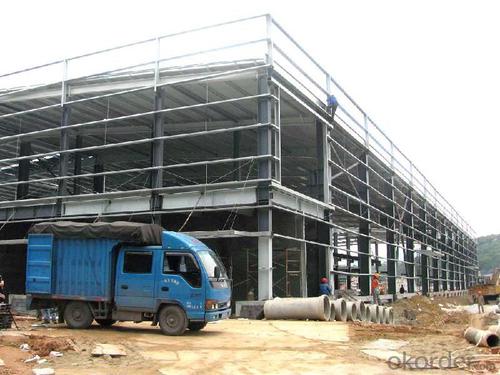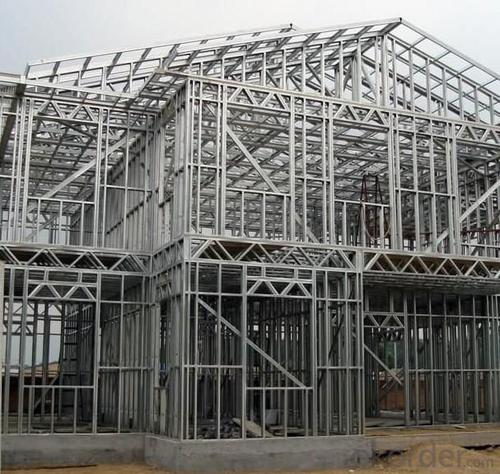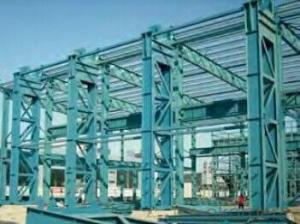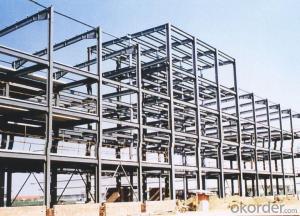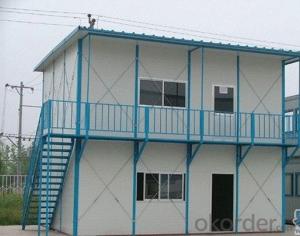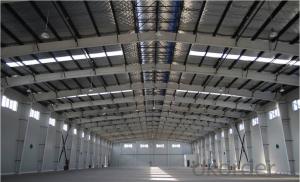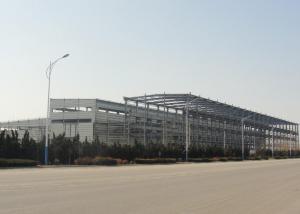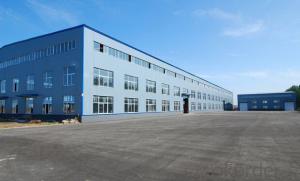China Steel Structure Workshop
- Loading Port:
- China Main Port
- Payment Terms:
- TT OR LC
- Min Order Qty:
- -
- Supply Capability:
- -
OKorder Service Pledge
OKorder Financial Service
You Might Also Like
Steel Structure Building
1.the connection method of steel structure:
welding connection or bolt connection
2.Steel structure design common norms are as follows:
"Steel Design Code" (GB50017-2003)
"Cold-formed steel structure technical specifications" (GB50018-2002)
"Construction Quality Acceptance of Steel" (GB50205-2001)
"Technical Specification for welded steel structure" (JGJ81-2002, J218-2002)
"Technical Specification for Steel Structures of Tall Buildings" (JGJ99-98)
3.The characteristics of steel
Light weight steel structure
Higher reliability of steel work
Steel anti-vibration (earthquake), impact and good
Steel structure for a higher degree of industrialization
Steel can be assembled quickly and accurately
Large steel interior space
Likely to cause sealing structure
Steel corrosive
Poor fire-resistant steel
Recyclable steel
Steel shorter duration
4.Commonly used steel grades and performance of steel
Carbon structural steel: Q195, Q215, Q235, Q255, Q275, Q345,etc.
High-strength low-alloy structural steel
Quality carbon structural steel and alloy structural steel
Special purpose steel
5.Market:
Products have been all over the country more than 20 provinces, municipalities and autonomous regions, and have been exported to Europe, North America, the Middle East, Africa, Asia and other countries and regions, the widespread use
- Q: What are the requirements for designing steel commercial buildings?
- The requirements for designing steel commercial buildings include understanding the project goals, conducting a structural analysis, determining load-bearing capacities, considering building codes and regulations, selecting appropriate materials, ensuring fire and safety codes compliance, and coordinating with other professionals involved in the project such as architects and engineers.
- Q: What does nonstandard steel structure mean?
- Non standard equipment is non standard equipment, non-standard equipment is compared with standard equipment (GB, HG, JB and so on national or industry standards) in terms of not in accordance with the unified national industry standards and specifications for manufacturing equipment, but according to their own need to use their own design and manufacture of the equipment. Equipment whose appearance or performance is not in the catalogue of national equipment products.
- Q: What are the design considerations for steel mezzanine floors?
- In the process of designing steel mezzanine floors, there are several important factors that need to be taken into consideration: 1. The weight-bearing capacity of the steel mezzanine floors must be able to support the equipment, machinery, or materials that will be placed on them. Therefore, it is crucial to calculate the maximum load capacity and ensure that the structural design can handle the anticipated loads without any risk of collapse or failure. 2. The design of the steel mezzanine floors must ensure structural integrity and stability. This involves considering factors such as the span of the floor, the size and spacing of the supporting columns, and the connection details between the floor and the existing building structure. Adequate bracing and reinforcement should also be incorporated to enhance the overall stability of the mezzanine. 3. It is essential to comply with local building codes and regulations when designing steel mezzanine floors. These codes typically specify requirements regarding fire safety, means of egress, access and exit points, and structural stability. Consulting with a structural engineer or an architect familiar with local regulations is important to ensure compliance. 4. Designing for accessibility and safety is crucial in order to protect workers and prevent accidents. This includes incorporating proper staircases or ladders for access, installing guardrails or handrails along open edges, and ensuring adequate lighting and ventilation. Additionally, fire protection measures, such as sprinkler systems and fire-rated materials, should be considered. 5. If the mezzanine is being incorporated into an existing building, it is important to ensure that the design seamlessly integrates with the existing infrastructure. This may involve coordinating with other trades, such as electrical and HVAC, to ensure proper placement of utilities and services. 6. Designing with future flexibility in mind is beneficial, as it allows for potential modifications or expansions. This can be achieved by allowing for adjustable connections, using modular components, and incorporating a design that can accommodate potential changes in use or layout. In summary, when designing steel mezzanine floors, it is crucial to consider load capacity, structural integrity, compliance with building codes, accessibility and safety, integration with existing infrastructure, and future flexibility. By addressing these considerations, a well-designed steel mezzanine floor can provide a safe and efficient space for various applications.
- Q: What are the factors to consider when designing steel structures for healthcare facilities?
- When designing steel structures for healthcare facilities, several factors need to be considered. These include the specific requirements and regulations of healthcare facilities, such as infection control, patient safety, and accessibility. The structural integrity of the building, including load-bearing capacity and resistance to natural disasters, is crucial. Additionally, considerations must be made for the functionality and flexibility of the space to accommodate medical equipment, technology, and future expansions. Energy efficiency, sustainability, and the integration of advanced building systems are also important factors to ensure a safe and efficient healthcare environment.
- Q: How are steel structures designed for foundation settlement?
- Steel structures are designed for foundation settlement by implementing various measures such as flexible connections, deep foundations, and monitoring systems. Flexible connections allow the steel structure to accommodate minor settlement by providing a degree of flexibility between the foundation and the superstructure. Deep foundations, such as piles, are used to transfer the load of the structure to deeper, more stable soil layers, reducing the impact of settlement. Additionally, monitoring systems are installed to continuously assess and measure any settlement that may occur, allowing for timely interventions and adjustments to maintain the structural integrity of the steel structure.
- Q: How is steel used in stadiums and sports arenas?
- Steel is used in stadiums and sports arenas for various purposes, such as constructing the framework and support structures, creating grandstands and seating areas, building roof systems, and reinforcing the overall infrastructure. The strength, durability, and versatility of steel make it an ideal material for constructing large-scale sporting venues that can withstand heavy loads, provide ample seating capacity, and ensure the safety of spectators.
- Q: What are the different types of steel members used in structures?
- There are several different types of steel members used in structures, including beams, columns, trusses, and plates. Beams are horizontal members that support loads by resisting bending, while columns are vertical members that provide structural support and stability. Trusses are composed of interconnected members that form triangular shapes and are used to support roofs, bridges, and other structures. Plates are flat steel members used for various purposes, such as floor and wall panels, as well as in the construction of tanks and vessels. These different types of steel members play crucial roles in providing strength and stability to structures.
- Q: How are steel industrial buildings constructed?
- Steel industrial buildings are constructed using a combination of pre-engineered steel components and traditional construction methods. The process typically involves designing the structure, fabricating steel components off-site, and then assembling them on-site. This ensures a quick and efficient construction process. The steel components are bolted or welded together to create the framework, and then additional materials such as cladding, insulation, and roofing systems are added to complete the building.
- Q: How do steel structures perform in seismic zones?
- Steel structures perform well in seismic zones due to their inherent strength and flexibility. The high strength-to-weight ratio of steel allows buildings to withstand the lateral forces generated during an earthquake. Additionally, the ductility of steel enables it to absorb and dissipate seismic energy effectively, reducing the potential for structural damage. These characteristics make steel structures a preferred choice in seismic zones as they provide superior performance and enhance the safety of occupants.
- Q: How are steel structures used in research laboratories and scientific facilities?
- Steel structures are widely used in research laboratories and scientific facilities for a variety of reasons. One of the primary advantages of steel is its strength and durability. Steel structures are capable of withstanding heavy loads and can support the weight of complex scientific equipment and machinery. In research laboratories, steel structures are often used to create the framework for the building. This framework provides a strong and stable base on which the laboratory can be built. Steel beams and columns are used to support the roof, walls, and floors, ensuring the structural integrity of the building. This is especially important in scientific facilities where delicate and sensitive experiments are conducted, as any movement or vibration can disrupt the accuracy of the results. Another key benefit of steel structures in research laboratories is their versatility. Steel can be easily customized and fabricated to meet the specific requirements of the facility. This allows for the creation of complex and unique designs, enabling scientists and researchers to optimize the use of space and create innovative layouts within the laboratory. The flexibility of steel structures also allows for easy expansion or modification of the facility as research needs change over time. Furthermore, steel structures offer excellent fire resistance, which is crucial in research laboratories where hazardous materials and chemicals are often used. Steel is a non-combustible material, meaning it does not contribute to the spread of fire. This provides an added layer of safety and protection for both researchers and valuable equipment. Additionally, steel structures are known for their cost-effectiveness and speed of construction. Steel is a lightweight material compared to other traditional building materials such as concrete or wood, which reduces the need for extensive foundation work. This results in shorter construction times and lower labor costs. Moreover, steel structures require minimal maintenance and have a long lifespan, making them a cost-efficient choice for research laboratories and scientific facilities. In summary, steel structures play a vital role in research laboratories and scientific facilities. Their strength, durability, versatility, fire resistance, and cost-effectiveness make them the ideal choice for creating the framework of these specialized buildings. Steel structures provide the stability, safety, and flexibility required to conduct complex experiments and research, enabling scientists and researchers to focus on their work and push the boundaries of scientific knowledge.
Send your message to us
China Steel Structure Workshop
- Loading Port:
- China Main Port
- Payment Terms:
- TT OR LC
- Min Order Qty:
- -
- Supply Capability:
- -
OKorder Service Pledge
OKorder Financial Service
Similar products
Hot products
Hot Searches
Related keywords


